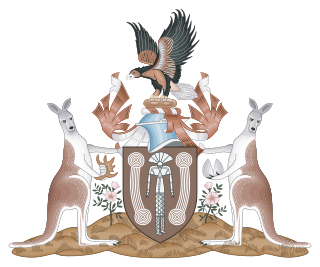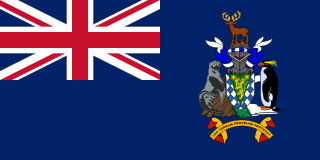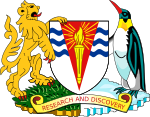
The coat of arms of Prince Edward Island, officially the King's Arms in Right of Prince Edward Island, are the coat of arms of Prince Edward Island, being the arms of King Charles III in right of the province. They were created when the shield and motto in the achievement were granted in 1905 by royal warrant from King Edward VII. The latest iteration was given by the Canadian Heraldic Authority in 2002.

The coat of arms of Nunavut was granted by a warrant of Roméo LeBlanc, Governor General of Canada, dated 31 March 1999, one day before the territory of Nunavut, Canada, was created. The same document specified the flag of Nunavut.

The coat of arms of the Northern Territory is the official heraldic symbol representing the Australian territory. They were officially granted by royal warrant from Queen Elizabeth II on 11 September 1978. The arms, uniquely in Australia, incorporate all of the territory's floral, animal and bird emblems: the Sturt's desert rose, red kangaroo and wedge-tailed eagle.

The coat of arms of Anguilla is the heraldic device consisting of a shield charged with three orange dolphins leaping over the sea. Adopted in 1990, it has been the coat of arms of Anguilla since that year. The escutcheon is featured on the flag of the territory.

The coat of arms of the Bahamas contains a shield with the national symbols as its focal point.

The coat of arms of Belize was adopted upon independence, and the current coat of arms is only slightly different from that used when Belize was a British colony.

In heraldry, an ordinary is one of the two main types of charges, beside the mobile charges. An ordinary is a simple geometrical figure, bounded by straight lines and running from side to side or top to bottom of the shield. There are also some geometric charges known as subordinaries, which have been given lesser status by some heraldic writers, though most have been in use as long as the traditional ordinaries. Diminutives of ordinaries and some subordinaries are charges of the same shape, though thinner. Most of the ordinaries are theoretically said to occupy one-third of the shield; but this is rarely observed in practice, except when the ordinary is the only charge.

The coat of arms of Toronto is a heraldic symbol used to represent the city Toronto. Designed by Robert Watt, the Chief Herald of Canada at the time, for the City of Toronto after its amalgamation in 1998. The arms were granted by the Canadian Heraldic Authority on 11 January 1999.

The coat of arms of Sunderland is the official heraldic arms of the City of Sunderland in England.

The flag of the British Antarctic Territory was granted on 21 April 1998. It features the coat of arms granted on 1 August 1963, a year after the British Antarctic Territory, a British Overseas Territory, was created. Previously, the Territory was a part of the Falkland Islands Dependencies and used the same flag. On 30 May 1969, a blue ensign with the British Antarctic Territory coat of arms in the fly was introduced as a civil ensign.

The flag of South Georgia and the South Sandwich Islands was granted on 3 October 1985, when the Territory was created. Previously the Territory was a part of the former Falkland Islands Dependencies and used the same flag as the Falklands Islands.

The coat of arms of Edmonton is the heraldic symbol used to represent the city. The coat of arms was granted to Edmonton on 28 October 1994.

The coat of arms of Sierra Leone, were developed by the College of Arms and granted in 1960.

The coat of arms of South Georgia and the South Sandwich Islands was granted in 1985, upon the creation of the territory. Prior to 1985, South Georgia and the South Sandwich Islands were a dependency of the Falkland Islands, and used their coat of arms. However, prior to 1962, the islands were grouped with what is now the British Antarctic Territory and their coat of arms was used instead of the Falkland Islands’ arms.

The coat of arms of Namibia is the official heraldic symbol of Namibia. Introduced at the time of independence in 1990, it superseded the earlier coat of arms used by the South African administration of the territory.

The coat of arms of the Government of Northern Ireland was granted to the Executive Committee of the Privy Council of Northern Ireland in 1924.

The coat of arms of Norfolk Island is the official symbol of the island and external Australian territory of Norfolk Island. It was granted by a Royal Warrant of Queen Elizabeth II on 20 October 1980.

The Coat of arms of West Yorkshire Metropolitan County Council was granted in 1975 to the new Metropolitan county council created in the previous year. The County Council was abolished in 1986 under the provisions of the Local Government Act 1985 and consequently the arms are no longer used. The current West Yorkshire Combined Authority uses a wordmark consisting of the authorities name.

The coat of arms of Malawi is based on the earlier heraldic arms of Nyasaland. It is supported by a lion and a leopard, above a scroll reading "Unity and Freedom". A rising sun in a black field, like in the lower field in the shield, is also present in the flag of Malawi.

Charles V, Holy Roman Emperor was the heir of several of Europe's leading royal houses. In 1506, he inherited the Burgundian Netherlands, which came from his paternal grandmother, Mary of Burgundy. In 1516, Charles became the king of Spain, inheriting the kingdoms first united by his maternal grandparents, Isabella I of Castile and Ferdinand II of Aragon. Finally, on the death of his paternal grandfather in 1519, Maximilian I, Holy Roman Emperor, he inherited the Habsburg lands in central Europe and was elected Holy Roman Emperor.





















